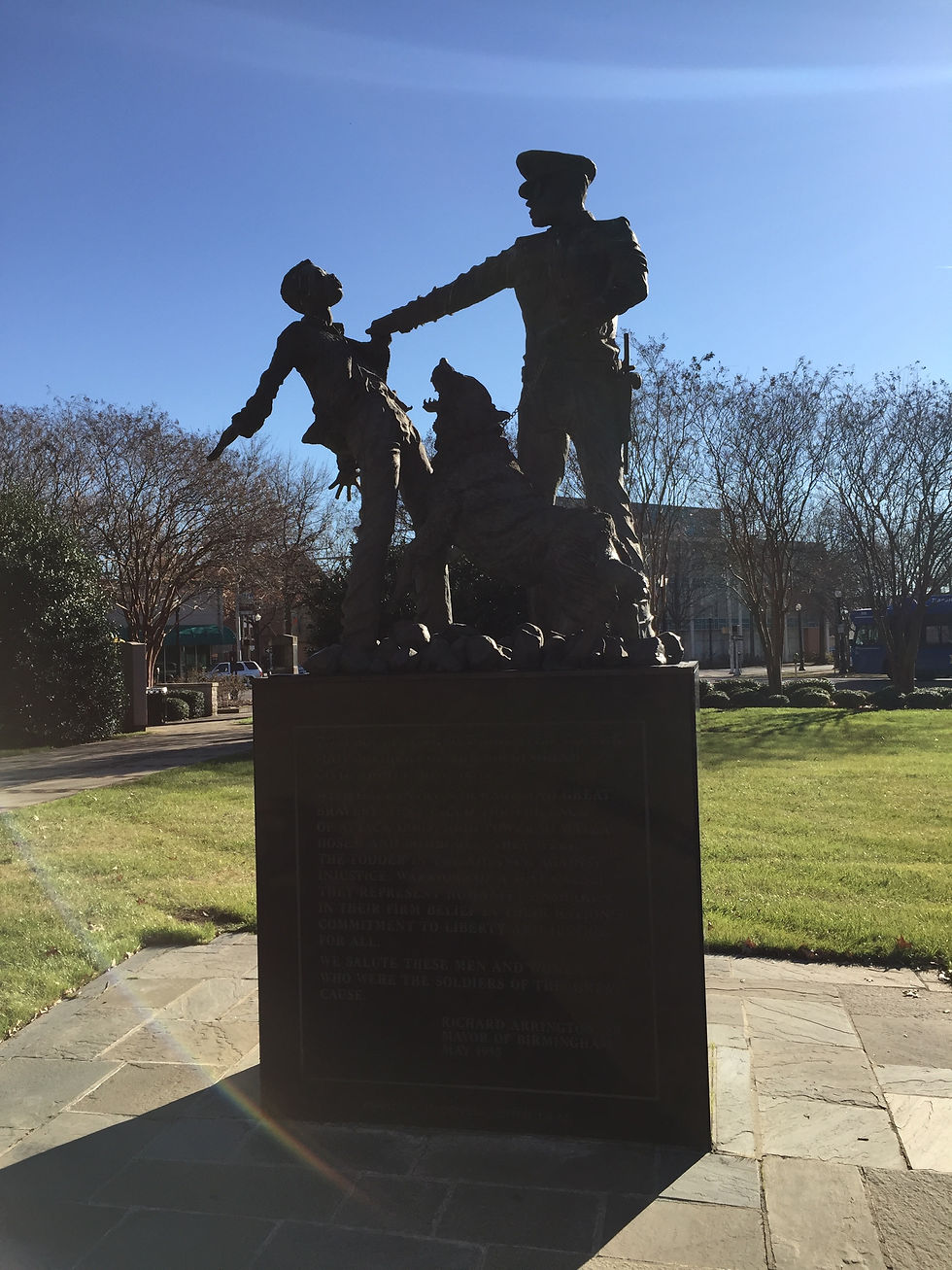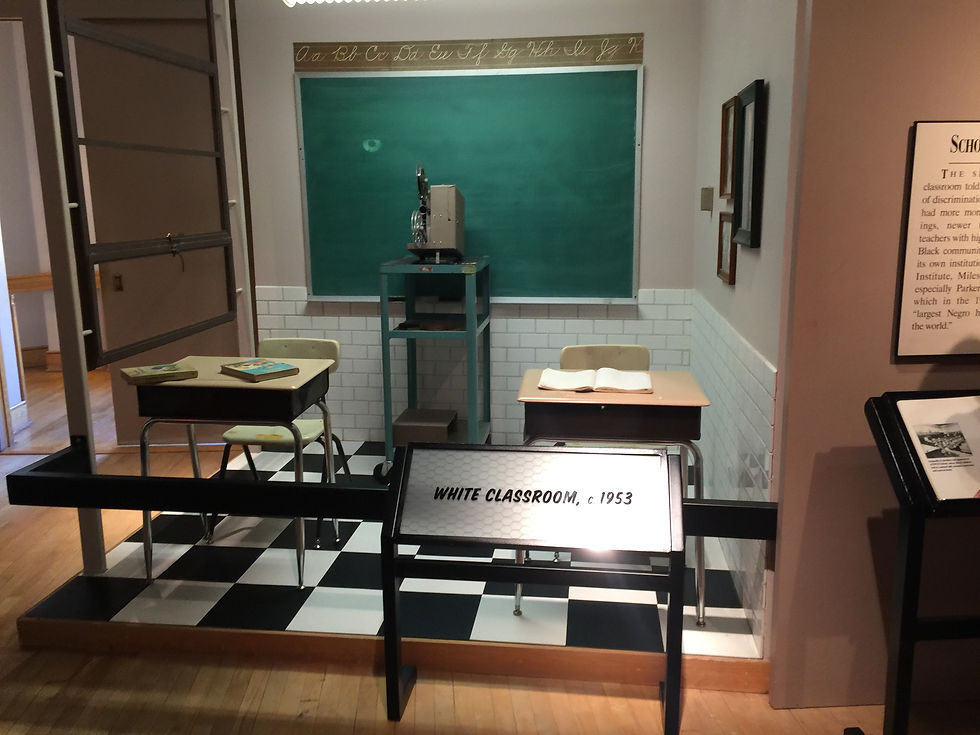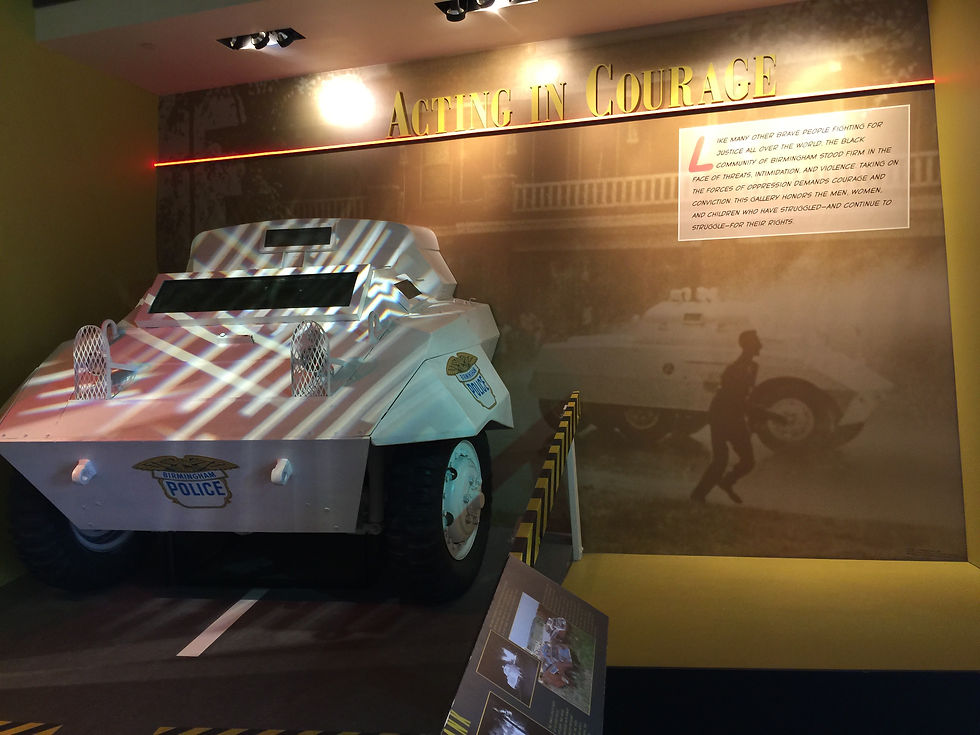Sonya's Blog - Day 221 - Birmingham Civil Rights Institute
- Sonya
- Jan 29, 2016
- 8 min read
Sonya’s Blog - Day 221 - January 29th - Birmingham Civil Rights Institute
Today is a learning day for all of us. We are heading to the Birmingham Civil Rights Institute to learn about the struggles in the Civil Rights Movement of the 1960’s. Birmingham was the most segregated city in the Southern States and the people in positions of power were willing to hold onto that segregation with all their might. There were many peaceful protests in Birmingham that were violently opposed by the authorities with tragic and unnecessary consequences. It is still hard to believe that 100 years after the end of the Civil War that Blacks were still fighting for basic rights in a country that wears its freedom and democracy like a badge of honour.
It took us awhile to get on the road. We decided to take Kizmet because there is a park across the street from the Museum that we wanted to walk around in. It wasn’t going to be hot enough today, so she could stay in the truck while we were in the museum. We managed to find parking right beside the park, which was super handy.
The park we wanted to walk around in was Kelly Ingram Park. This is an historic park that was the site of civil rights rallies, demonstrations and confrontations in the 1960’s. It is a 4-acre park and there are several stations for you to stop at. Each station has a sculpture that depicts the conflicts between demonstrators and police. There is a corresponding audio tour that you can access through your cell phone that augments each sculpture and describes the events that lead up to it’s depiction. This park became the epicentre of the National Civil Rights Movement (and was called West Park at that time) and became the international focus for civil disobedience for blacks demanding equality. During the Birmingham Campaign, many of the protestors were arrested and they decided to enlist the children to demonstrate. The kids were eager to have their voice heard and 1000 kids headed out to protest. Bull Connor (the Police Commissioner), was undeterred, and ordered police dogs and fire hoses unleashed on the demonstrators. 600 of the children were arrested. The next day 1000 more kids came out to demonstrate and Bull Connor set up make shift jails so he could continue to make arrests. By this time the protests in Birmingham were getting National attention and famous photographs were taken of the confrontations between the police and the protestors. This lead to National outcry and the eventual involvement of Federal forces, which the governor of Alabama was furious about and felt it was a State issue and they were dealing with it just fine. Well they were certainly dealing with it, but nothing was fine about it. The sculptures in the park depicted the violence unleashed on the peaceful demonstrators. The water was at such high pressure that it could strip bark off trees, but the police commissioner ordered it aimed at the peaceful demonstration to break it up.
Station 1 - The police attack dogs:

Station 2 - A demonstrator being confronted by a policeman and his dog:

Station 3 - The children in jail - “We ain’t afraid of no jail” was the caption:

Station 4 - The high powered fire hoses being aimed at demonstrators, mostly children.

Station 5, 6 and 7 - I do not have pictures of these. Station 5 was peace fountains, but they were turned off. It was to depict the harmony and peace that they hoped to achieve with desegregation. Station 6 was a when three priest kneeled down to pray (I missed this one) and Station 7 was Martin Luther King Jr (The sun was on my camera and I couldn’t see well and did not get a picture of the full statue). You can see his statue behind the statue of the girls in Station 8.
Station 8 - was the memorial to the four girls murdered in the bombing of the 16th street Baptist Church and to the two young boys who were killed on the same day in when violence broke out after angry protesters showed up at the church and were confronted by police and state troopers.

Station 9 was Reverend Shuttlesworth, who lead many of the civil rights actions and began the Birmingham Campaign.

We decided to head into the Civil Rights Institute, so we put Kizmet in the car with the windows opened a bit (the breeze was nice and cool) and headed across the street. We started our tour with a movie detailed the history of Birmingham which was established after the Civil War. The location was picked due to the large iron ore deposits and the intersection of railroads. The movie gave us a brief history of the establishment of the city and how there were many blacks, now free from slavery, looking for employment opportunities. There were many whites looking for opportunities as well and Birmingham was founded. Immediately the city had distinct white and black areas, but there was no strict segregation. As the city became more and more successful the divisions became clearer and clearer, with informal and formal laws governing blacks, and by 1901 formal segregation laws (Jim Crow Laws) were being put into place, specifically designed to keep blacks from fully participating in American society. Blacks and whites lived completely separate lives in all aspects of life, including death. As a result of segregation, blacks established a completely separate city within a city by necessity. Blacks started their own businesses, schools, churches, etc and created a thriving community. They were underfunded by the government, but managed to create a strong, thriving community nonetheless. The movie ends at this point and the screen lifts up and this is where the museum starts.
There are many displays detailing the segregation in Birmingham, from fountains for whites to fountains for coloured, to workplace segregation, church, business, school, etc. It was very well set up with a demonstration soda shop, barber, school, church and a depiction of the typical home in the black section. There was also a description of Jim Crow and why the laws were referred to as Jim Crow Laws. Jim Crow was a popular caricature in the 1830’s, depicted by a white man (Thomas D. Rice) in blackface which became hugely popular. As a result of this popularity “Jim Crow” became a pejorative term meaning “Negro”. As a result when segregation laws started to be enacted in the southern states they were often referred to as Jim Crow laws.




The displays then moved into the 1950’s and the start of civil disobedience with lunch counter sit-ins, which was the kick start to the Civil Rights movement. The Museum continues to move through time-lines and describe how the movement gained momentum and the often violent push back by the white ruling class. Important events are described, like the Montgomery Bus Boycott in 1955, which was kick started by Rosa Parks refusing to give up her seat on the bus. Rosa Parks became an international icon of resistance to racial segregation even though she was not the first person to resist racial segregation on the busses. The bus boycott lasted for 13 months when the Supreme Court ruled that Alabama and Montgomery laws requiring segregated buses to be unconstitutional. It was a victory, but came at heavy costs and lots of violent backlashes from white supremacists.
The displays moved to describe lunch counter sit-ins, starting in Greensboro, SC at a Woolworth’s lunch counter. This sit-in lead to sit-in’s all across the country protesting segregation.

Freedom Riders on Greyhound buses in 1961 from Washington, DC, carrying both white and black passengers. There were more than 400 volunteers who traveled throughout the Southern States to challenge the non-enforcement of Supreme Court rulings banning segregation on public buses. It also ruled that segregation was outlawed in restaurants and waiting rooms in terminals that served buses that crossed state lines, which the southern states completely ignored. The first bus of Freedom riders had every intention of traveling from Washington, D.C. to New Orleans to challenge the continuing segregation. Violent mobs greeted them in Alabama. Just outside Anniston the bus was firebombed. The mob tried to hold the doors shut so that nobody could escape, but they were able to in the end and nobody was killed. They were attacked upon their escape, but warning shots fired into the air by highway patrolmen stopped a lynching from taking place. When the bus reached Birmingham, another mob awaited and they were beaten again, the white supporters were beaten very badly. Despite the violence the Freedom Riders wanted to continue and by this time the had a federal escort (ordered by President Kennedy). All the riders were arrested in Montgomery and could not continue. Freedom Riders continued to ride buses in protest throughout 1961 often with violent resistance by mobs of the KKK.
Next was a display of the March on Washington and Martin King Jr. speech.

Details of the protests in Birmingham and the bombing of the church. Bull Conor was the Police Commissioner of Birmingham at the time and a brutal racist. He would stop at nothing to keep the Black population segregated, including the Police Dog attacks and the water cannons. Park is just across the street where we were earlier looking at all the sculptures. Bull Connor also had two armoured vehicles which he liked to use to keep everyone in order through intimidation tactics.

The rest of the museum talked about the dismantling of segregation laws and the election of Birmingham’s first black mayor, Richard Arrington, Jr., in 1979. He served as Birmingham’s mayor for 20 years. He helped to reform the police force and to create jobs as the economy was in trouble.


Here is a picture of the 16th Street Baptist Church that was famously bombed by the KKK. It took 10 years for one arrest to be made and charges brought forth in this crime, even though the authourities knew within a year who the perpetrators were. It took several more years for two more men to be charged and the fourth suspect died before being charged. This church was the main hub of the black community and for the Civil Rights movement in Birmingham. Bombings in Birmingham were quite common during the struggle for desegregation and it was sometimes referred to as Bombingham during this time.

When we were done in the museum we went and gave Kizmet another walk, but decided to head out. Birmingham is clearly still struggling with social issues and we experienced some of them first hand in the park. Lots of homelessness and Blake and the kids had a little chat with a drunk couple. Not really where we wanted to have lunch. It is unfortunate, but a struggle in all major cities. Certainly Birmingham is not the first place we have witnessed it, New York and Washington were far worse. Just sad to see.
We headed back towards the RV, but had to stop for groceries. We found a Whole Foods and stopped in there. We were clearly in the more affluent neighbourhood, lots of fancy cars and a very nice grocery store. We got our few groceries, plus they had good wifi so I was able to send off the kids report cards to our advisor with the homeschool division of the CBE. It was good to get that done and out of the way. We had a large snack while we were there because we were all hungry.
We didn’t do much when we got back. Nobody was hungry for supper. Blake and Isaac had a fire and I worked on writing up my blogs. We leave for Memphis tomorrow.
Sonya











Comments